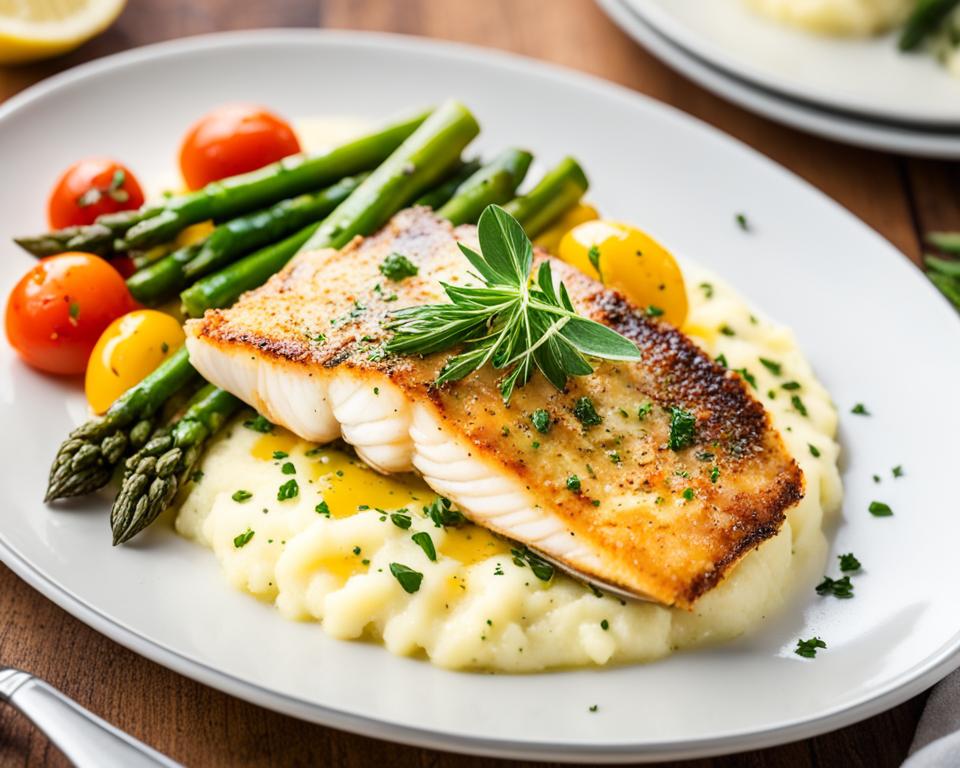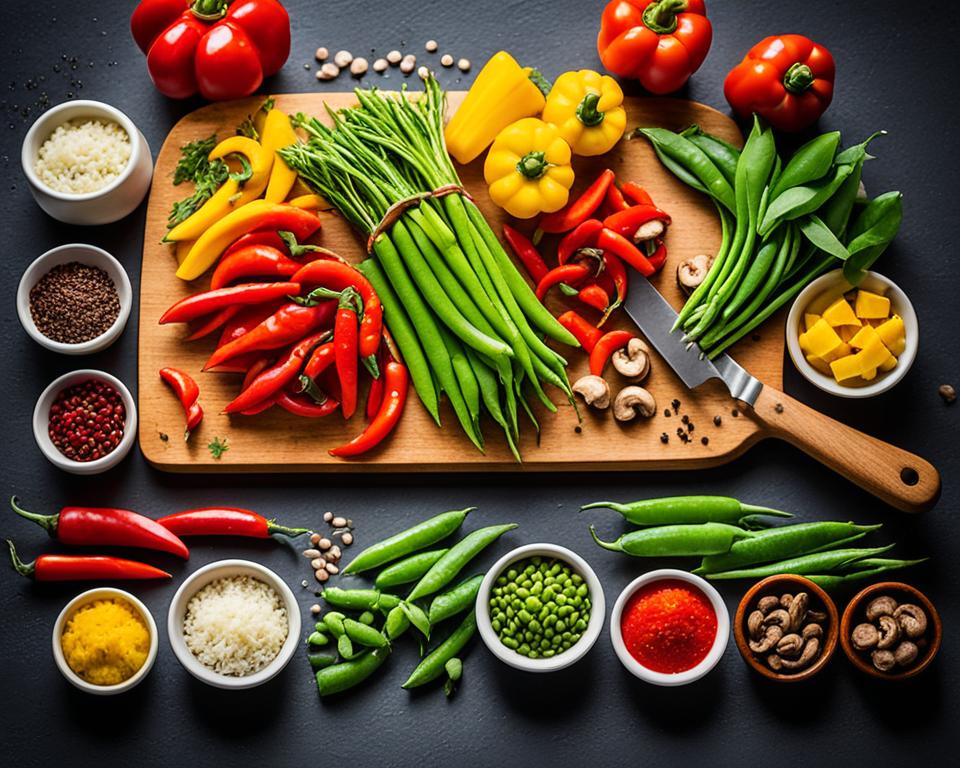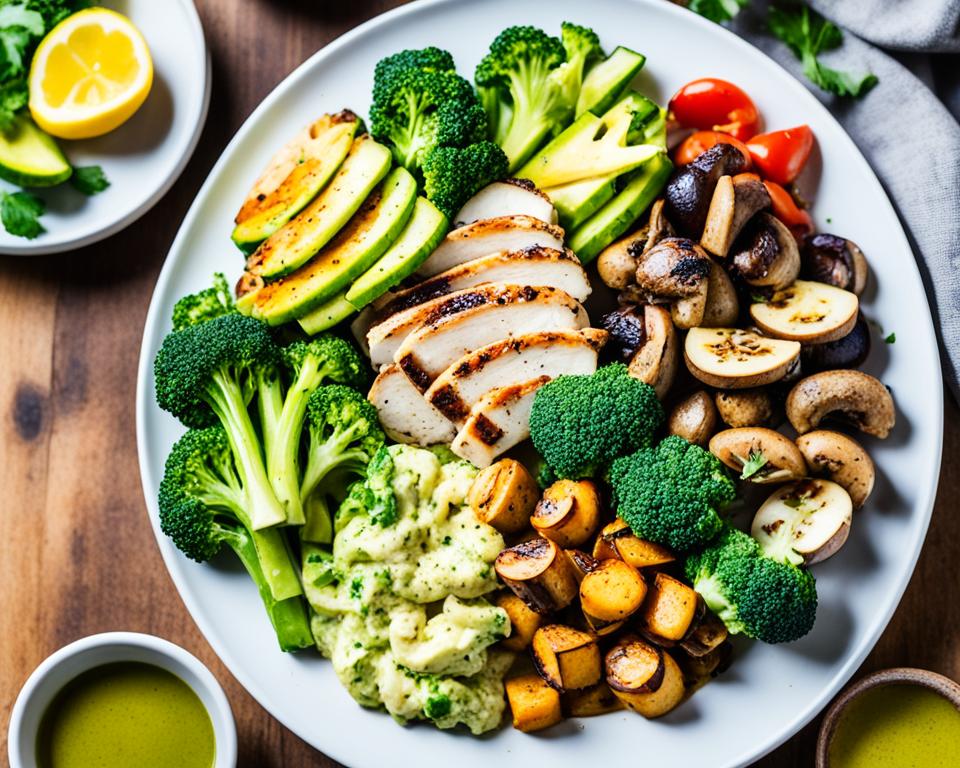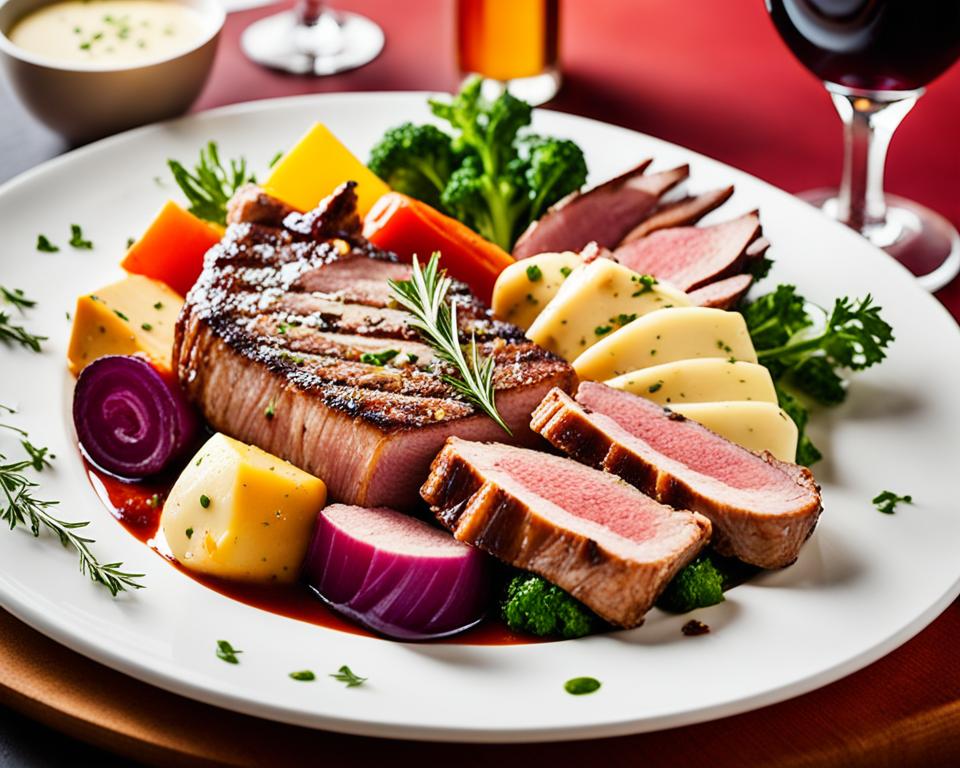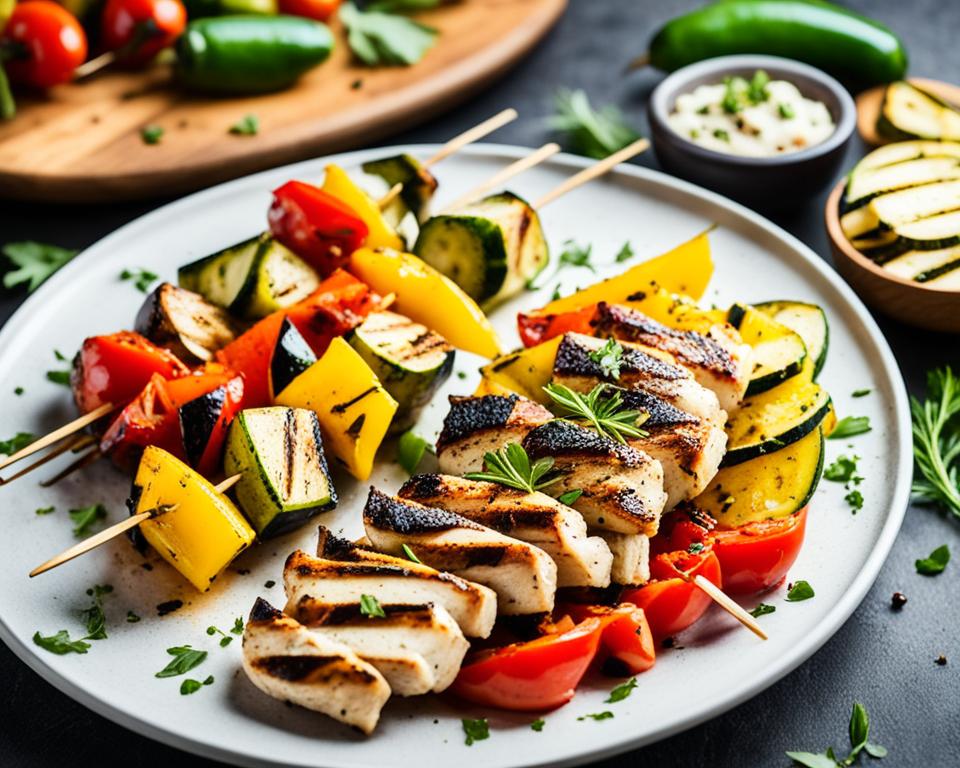Welcome to our guide to making an easy and delicious flounder dinner that is sure to impress your taste buds. This quick flounder dinner recipe will have you enjoying a flavorful meal in no time. Flounder is a versatile fish known for its delicate texture and mild taste, making it perfect for a variety of dishes. With our simple recipe, you can create a mouthwatering meal that is both easy to prepare and satisfying to eat.
Key Takeaways:
- Flounder is a white saltwater fish with a mild flavor and flaky texture.
- This recipe features a one-pan baked flounder with a bold and lemony Mediterranean sauce.
- Flounder pairs well with a variety of side dishes, such as zucchini and red onion or herby boiled potatoes.
- Ensure the flounder is cooked to an internal temperature of 140-145 degrees F.
- If you can’t find flounder, you can substitute it with other thin fish fillets like branzino, halibut, or sole.
What Goes Well with Flounder?
Flounder is a versatile fish that pairs deliciously with a variety of side dishes. While the recipe suggests serving it with zucchini and red onions, there are plenty of other fantastic options to explore. Whether you’re looking for starchy sides or fresh vegetables, you can customize your flounder dinner to suit your taste preferences.
Starchy Side Dishes
- Herby boiled potatoes
- Smashed potatoes
Fresh Vegetable Options
- Roasted broccoli
- Greek green bean salad
- Asparagus salad
These side dishes perfectly complement the mild flavor and delicate texture of flounder, creating a well-balanced and satisfying meal. Feel free to mix and match or try out different combinations to discover your favorite pairing. The flexibility of flounder allows you to get creative and enjoy a variety of flavors with every bite.
How to Make Baked Flounder
The recipe for baked flounder is simple and easy to follow. By following these step-by-step instructions, you can create a delicious flounder dinner that will impress your family and friends.
Ingredients for Baked Flounder:
- 2 flounder fillets
- Salt and pepper to taste
- 2 cloves of garlic, minced
- 1 teaspoon dried oregano
- 1/2 teaspoon paprika
- 1/2 teaspoon cumin
- Juice of half a lemon
- 2 tablespoons olive oil
- Assorted vegetables (zucchini, red onion, etc.)
- Grated Parmesan cheese for topping
Instructions:
- Preheat your oven to 350 degrees F.
- Season the flounder fillets with salt and pepper on both sides.
- In a small bowl, mix together the minced garlic, dried oregano, paprika, cumin, lemon juice, and olive oil.
- Place the flounder fillets and assorted vegetables on a baking dish or sheet.
- Pour the sauce over the fish and vegetables, ensuring everything is evenly coated.
- Bake in the preheated oven for 7 to 10 minutes. The fish should be opaque and flake easily with a fork.
- Remove the dish from the oven and sprinkle the grated Parmesan cheese over the fish.
- Return the dish to the oven and bake for an additional 5 minutes, or until the cheese is melted and golden.
- Remove from the oven and let it cool for a few minutes before serving.
This baked flounder recipe is a perfect choice for a quick and flavorful dinner. The combination of herbs, spices, and lemon juice enhances the natural taste of the flounder, while the Parmesan cheese gives it a deliciously cheesy finish.
What Can I Use if I Can’t Find Flounder?
If you’re unable to find flounder for this recipe, don’t worry! There are several other fish options that can be used as substitutes. Consider using the following thin fish fillets that cook at a similar speed to flounder:
- Branzino
- Halibut
- Sole
- Cod
- Trout
- Snapper
- Haddock
When using a substitute fish, it’s important to note that the cooking time may need to be adjusted slightly depending on the type of fish used. However, the internal temperature should still reach 140 to 145 degrees F for proper doneness.
Experiment with different fish options to find the one that suits your taste buds best. Each type of fish will bring its own unique flavor and texture to the dish, allowing you to create a delicious flounder-inspired dinner even if you can’t find the exact fish.
Remember, cooking is all about creativity and flexibility, so don’t be afraid to explore alternatives and make the recipe your own!
Leftovers and Storage
Once you’ve enjoyed your delicious flounder dinner, you may find yourself with some leftovers. Don’t worry, you can easily store and reheat them for another enjoyable meal.
To maintain the flavor and texture of the fish, it’s important to store the leftover cooked flounder properly. Simply place it in an airtight container and store it in the refrigerator. The flounder can be safely stored for up to 2 days.
When it’s time to enjoy the leftovers, it’s recommended to eat them at room temperature to avoid overcooking with reheating. This will help preserve the delicate flakiness of the fish.
If you prefer to have your leftovers warm, you can gently reheat them in a skillet over medium-low heat. Take care not to overheat the fish, as this can lead to a loss of moisture and tenderness.
By following these storage and reheating tips, you can savor the flavors of your flounder dinner again and again.

Important Tips for Cooking Flounder
When it comes to cooking flounder, there are a few essential tips to keep in mind. By following these guidelines, you can ensure that your flounder turns out delicious and perfectly cooked every time.
- Be mindful of the cooking time: Flounder fillets are thin and delicate, which means they can overcook quickly. It’s crucial to keep a close eye on the cooking time to prevent them from becoming dry. Check for doneness before the recommended cooking time stated in the recipe and adjust accordingly.
- Add Parmesan cheese towards the end: If your recipe calls for grated Parmesan cheese, it’s best to add it towards the end of the baking process. This ensures that the cheese melts properly and creates a delicious golden crust on top of the flounder.
- Use quality ingredients: The flavor of your flounder dish depends on the quality of the ingredients you use. Freshly squeezed lemon juice and extra virgin olive oil can elevate the taste of the fish, adding brightness and depth of flavor.
By following these tips, you’ll be able to create a delicious and quick flounder dinner recipe that will impress your family and friends.
What Should I Serve with Baked Flounder?
When it comes to serving baked flounder, the possibilities are endless. This versatile dish pairs well with a variety of side dishes, allowing you to create a complete and satisfying meal. Whether you’re looking for starchy options or refreshing salads, there are plenty of ideas to consider.
Starchy Side Dishes:
- Herby Boiled Potatoes: Serve your baked flounder with a side of tender, herby boiled potatoes. The combination of flavors creates a delightful contrast that enhances the overall dining experience.
- Smashed Potatoes: Create a rustic and flavorful side dish by serving smashed potatoes alongside your baked flounder. These crispy-on-the-outside, creamy-on-the-inside potatoes add a nice texture to the meal.
Healthy and Refreshing Salads:
- Roasted Broccoli: Add a nutritious touch to your meal by pairing your baked flounder with some roasted broccoli. The slight char and earthy flavor of the broccoli complement the delicate taste of the fish.
- Greek Green Bean Salad: Enjoy a burst of Mediterranean flavors with a Greek green bean salad. This tangy and refreshing dish adds a vibrant element to the meal.
- Asparagus Salad: Light and crisp, an asparagus salad is a perfect companion to baked flounder. The bright and fresh flavors of the asparagus enhance the overall taste of the dish.
When serving baked flounder, feel free to mix and match side dishes based on your personal preferences and dietary needs. Get creative and experiment with flavors to find the perfect combination that suits your taste buds.
<!– Table:
| Side Dish | Description |
|---|---|
| Herby Boiled Potatoes | Serve alongside baked flounder for a delightful combination of flavors. |
| Smashed Potatoes | Add a rustic and flavorful touch to your meal with crispy smashed potatoes. |
| Roasted Broccoli | Enjoy the nutritious benefits of roasted broccoli alongside your baked flounder. |
| Greek Green Bean Salad | Experience a burst of Mediterranean flavors with a tangy and refreshing green bean salad. |
| Asparagus Salad | Light and crisp, an asparagus salad adds vibrancy to your baked flounder meal. |
–>
How Do You Know When Flounder is Cooked?
Flounder is a delicate fish that requires precise cooking to achieve the perfect texture and flavor. So, how do you know when your flounder is cooked just right? There are a few indicators to look for:
- Internal Temperature: The internal temperature of the fish is the most accurate way to determine if it is cooked. For flounder, the ideal internal temperature is between 140 to 145 degrees F. Use a meat thermometer to check the temperature at the thickest part of the fillet.
- Color Change: Cooked flounder will turn from opaque to white in color. As it cooks, the translucent flesh transforms into a firm, white texture that easily flakes apart.
- Flakiness: Gently slide a fork into the fillet and twist it slightly. If the flesh flakes easily and separates into clean layers, the flounder is cooked. If the flesh still feels rubbery or resists flaking, it needs more time.
Keep in mind that fish continues to cook even after it is removed from the heat source, so it’s always better to slightly undercook the fish than to overcook it. Removing the flounder from the oven a couple of minutes early will prevent it from drying out and becoming tough.
In summary, a combination of checking the internal temperature, observing the color change, and ensuring flakiness will help you determine when your flounder is perfectly cooked. With these tips in mind, you’ll be able to enjoy the best flounder dinner recipe with confidence and delight.
Can I Use Frozen Flounder Instead of Fresh Flounder?
Yes, you can use frozen flounder in this quick flounder dinner recipe. It’s a convenient option when fresh flounder is not available. To ensure the best results, follow these steps:
- Thaw the frozen flounder overnight in the refrigerator. This slow thawing process helps retain the fish’s moisture and prevents texture issues.
- After thawing, pat the flounder dry with paper towels to remove any excess moisture. This step is crucial for achieving even cooking and a crispy exterior.
By properly thawing and drying the frozen flounder, you can achieve the same flavorful and flaky result as with fresh flounder.
Benefits of Using Frozen Flounder:
Using frozen flounder can have its advantages. It allows you to keep a stash of flounder on hand for those last-minute dinners. Plus, frozen flounder is often more affordable than fresh, making it a budget-friendly choice. Just remember to thaw and dry it thoroughly before cooking.
| Advantages of Using Frozen Flounder | Considerations |
|---|---|
| Convenient option when fresh flounder is unavailable | Thawing and drying process required |
| Allows you to keep a stash of flounder on hand | May be more affordable compared to fresh flounder |
Conclusion
Looking for an easy and delicious dinner option? This flounder dinner recipe is the perfect choice. With its flavorful Mediterranean sauce and melted Parmesan cheese, the baked flounder fillet is sure to satisfy your taste buds. The best part? It can be prepared in no time, making it a great option for busy weeknights.
Not only is this recipe quick and easy, but it also offers flexibility. If you can’t find flounder, feel free to substitute it with other white fish like branzino or sole. You can also customize your meal by pairing the flounder with your favorite side dishes. From herby boiled potatoes to roasted broccoli, there are plenty of options to choose from.
Whether you’re a seafood lover or simply looking for a healthy dinner option, this easy flounder dinner recipe is worth a try. Its delicious flavors, quick preparation, and versatility make it a winner in any kitchen. So why not give it a go and enjoy a tasty and satisfying meal tonight?
FAQ
What Goes Well with Flounder?
Flounder pairs well with a variety of side dishes. Some suggestions include zucchini and red onion, herby boiled potatoes, smashed potatoes, roasted broccoli, Greek green bean salad, or asparagus salad. The mild-flavored fish complements both starchy sides and fresh vegetables, allowing you to customize the meal to your preference.
How to Make Baked Flounder?
To make baked flounder, you will need to season the fish and vegetables with salt and pepper. Prepare a sauce by combining garlic, oregano, paprika, cumin, lemon juice, and olive oil. Pour the sauce over the fish and vegetables. Bake in a preheated oven at 350 degrees F for 7 to 10 minutes. Then, top with grated Parmesan cheese and bake for an additional 5 minutes until the flounder is flaky and the cheese has melted.
What Can I Use if I Can’t Find Flounder?
If you can’t find flounder, you can substitute it with branzino, halibut, sole, cod, trout, snapper, or haddock. Choose thin fish filets that will cook at a similar speed to flounder. The cooking time may need to be adjusted slightly depending on the type of fish used, but the internal temperature should be 140 to 145 degrees F when fully cooked.
Leftovers and Storage
Leftover cooked flounder can be stored in an airtight container in the refrigerator for up to 2 days. It’s recommended to eat the leftovers at room temperature to avoid overcooking with reheating. If desired, the leftovers can be heated in a skillet over medium-low heat until just heated through. Proper storage and reheating will help maintain the flavor and texture of the fish.
Important Tips for Cooking Flounder
When cooking flounder, be mindful of the cooking time as flounder fillets are thin and can overcook easily. Check for doneness before the recommended cooking time and adjust accordingly. Adding the Parmesan cheese towards the end of the baking process can help ensure it melts properly. Using quality ingredients like fresh lemon juice and extra virgin olive oil can enhance the flavor of the dish.
What Should I Serve with Baked Flounder?
Baked flounder can be served with a variety of side dishes. Some options include herby boiled potatoes, smashed potatoes, roasted broccoli, Greek green bean salad, or asparagus salad. The choice of side dishes can be tailored to personal preferences and dietary needs.
How Do You Know When Flounder is Cooked?
Flounder is cooked when it reaches an internal temperature of 140 to 145 degrees F. The fish will turn from opaque to white in color and flake easily with a fork. If you don’t have a meat thermometer, visual cues can also help determine the doneness of the fish.
Can I Use Frozen Flounder Instead of Fresh Flounder?
Yes, you can use frozen flounder in the recipe. However, it’s important to thaw the fish overnight in the refrigerator and pat it dry thoroughly to remove excess moisture. This ensures that the fish cooks evenly and prevents any texture issues. By following these steps, you can achieve the same flavorful and flaky result with frozen flounder as with fresh flounder.

